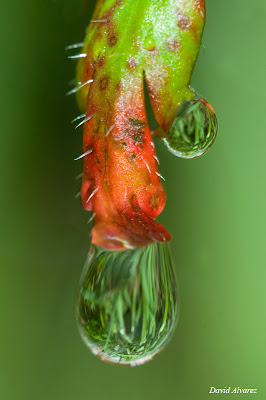In ecology and microhabitat understand the smallest part of an ecosystem that contains a distinctive flora and fauna. Normally microhabitat conditions that differ from those around it, determines the presence of these species. Typical examples of microhabitats are usually the humid forest enclosed in a valley or cave walls, erosion in some cases these microhabitats may be limited not only in space but also in time. An example are the plants that bloom during a certain time of year and attract a community of animals that only stays there a few days.
During these weeks, many of the meadows and forests of Northern Spain have flourished Gamon ( Asphodelus albus), a very characteristic plant by long poles, sometimes over a meter high, where their flowers. During the flowering plants they congregate in large numbers of insects and other small animals who come especially to sip the nectar, but also eat leaves and flowers and even hunt other animals.
and bumble bees take advantage of the days of plenty for making continuous trips from the flowers to the hive, and at one point I counted over 10 Hymenoptera 4 species that differs in one ear.
Zigaena trifolii
The zigenas, hundreds that have appeared on all pastures also stop at the Asphodel flowers to refuel. And as including dozens of species of butterflies that are attracted by the smell and the striking color of its petals.
sanjuaneros beetles (Melolontha melolontha ) also appear on the ears, but they have a penchant for dry and withered flowers. Is clear that even within a single plant specialists are taking advantage of each of its parts, trying to avoid competition with other species.
Statophaga stercoraria
Some insects, like the fly Statophaga stercoraria, which as its scientific name implies, has a predilection for the piles of manure, to temporarily change their diet feed on nectar. In a few days will be over the mana and return to their scatological habits.
Aral ( Thomisidae) catching a bee (Apis mellifera )
But as if they were the savannah of the Serengeti, the concentrations of herbivores and pollinators also attract predators. Crab spiders (Family Thomisidae ) has cryptic colors that blend with the environment where they are. Taking advantage of its "invisibility" wait patiently for an insect careless approach to launch a quick attack and catch. Once caught, the spider venom inoculated him and begin to digest it.
Within a few days, the flowers of Asphodel will have wilted and the plant begins to dry. This small temporary microhabitat disappear and the small community that had settled in their flowers and leaves will leave to find a new site.






































